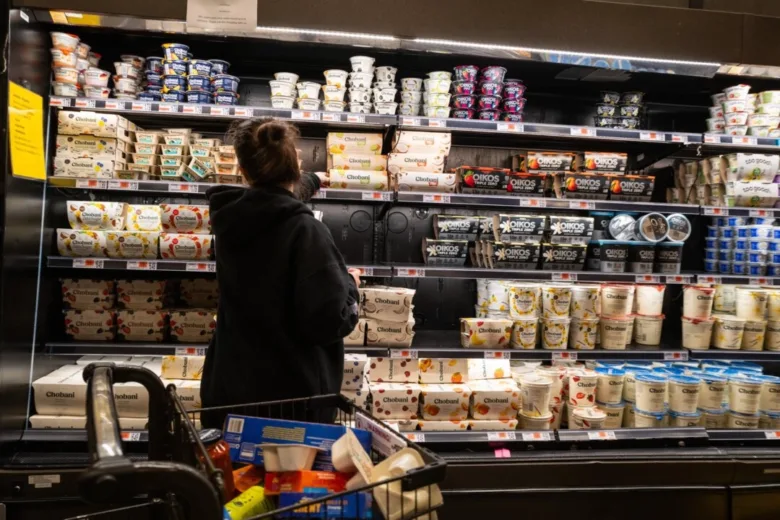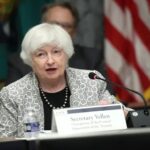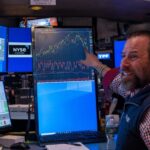By Tom Ozimek
U.S. consumer spending slowed sharply in the first half of 2025 as a cooling labor market, higher tariffs, and volatile equity markets weighed on household confidence, according to a new Fitch Ratings report and government data.
The pullback raises concerns about whether the resilience of American shoppers—who account for roughly two-thirds of gross domestic product—can continue into the year-end holiday season.
Fitch’s latest Consumer Health Monitor, released Aug. 21, showed that household spending growth decelerated to 0.5 percent in the first quarter and 1.4 percent in the second, down from nearly 4 percent in the second half of 2024.
Spending on durable goods—a bellwether of consumer confidence in big-ticket purchases—fell by an annualized 3.7 percent in the first quarter. Fitch attributed the decline to trade policy uncertainty and stock market volatility, which dented household sentiment.
The ratings agency expects consumer spending to average just 1.8 percent annually in 2025–26, a full percentage point below last year’s pace, and warned of a potential stagflation scenario.
“As tariff-related cost pass-throughs to goods increase inflationary pressure, the economy could take a stagflationary turn later this year,” Olu Sonola, head of U.S. Economic Research at Fitch, said in a statement. “Higher prices are expected to hit goods categories first, likely weakening consumer spending ahead of the holiday season.”
Government figures echo the cooling trend. Department of Commerce reported that retail and food services sales rose 0.5 percent in July, to $726.3 billion, after a 0.9 percent gain in June. Sales were 3.9 percent higher than a year earlier, but performance was uneven. Furniture, apparel, and online sellers posted increases, while building materials, electronics, and miscellaneous retailers saw declines.
Food services and drinking places—a key gauge of restaurant spending—fell 0.4 percent in July, confirming industry data showing plateauing demand after a strong run earlier in the year.
Even so, household spending has not collapsed. Credit and debit card use increased in July, and the Federal Reserve Bank of Atlanta projects gross domestic product growth of 2.3 percent in the third quarter. Consumers boosted outlays on autos, groceries, and digital retail purchases last month, offsetting softness in categories such as restaurants and building materials.
“Retail sales growth slowed a bit in July, perhaps illustrating that the tariff pull-forward effect is waning,” Ted Rossman, senior industry analyst at Bankrate, told The Epoch Times in an emailed statement. He was referring to consumers accelerating purchases in anticipation of tariff-related price hikes, a phenomenon often described as tariff front-running.
Still, consumer spending has been “more resilient than many expected,” he added, noting that households have continued to spend even as credit card balances and borrowing costs hover near record highs.
Corporate results highlight the uncertainty. Target warned it is planning “cautiously for the back half of the year” amid unpredictable trade policy. Home Depot reported a nearly 5 percent increase in second-quarter sales, but said tariff-related costs will force modest price increases in select categories.
“Value is very top of mind for consumers right now,” said Target’s incoming CEO, Michael Fiddelke. “They’re looking to stretch their budget; they’re looking to navigate inflation and uncertainty around tariffs.”
Since Feb. 1, more than 300 companies have responded in some way to the Trump administration’s tariffs, with roughly 38 consumer-focused firms lowering or withdrawing their forecasts and about 42 signaling price increases, according to Reuters’s global tariff tracker.
President Donald Trump has said that the global tariffs generate billions of dollars in federal revenue without stoking inflation. Treasury data show duties brought in a record $28 billion in July alone, more than triple the amount from a year earlier. White House officials point to stable Consumer Price Index readings—headline inflation held at 2.7 percent in July—as evidence that households are not being squeezed.
“The ‘panicans’ continue to be proven wrong by the data—President Trump’s tariffs are raking in billions of dollars, small-business optimism is at a five-month high, and real wages are rising,” White House press secretary Karoline Leavitt said.
She noted that inflation has averaged 1.9 percent since Trump took office, with energy prices down year over year and as well as staples such as eggs, which are 20 percent cheaper since January.
Andrew Moran contributed to this report.






